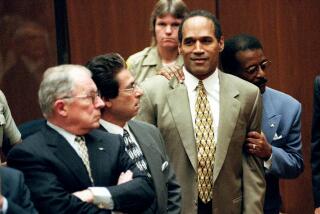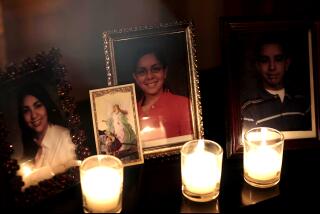The Door Closes on the Case and the Cause
Sometimes it is difficult to separate the case from the cause. Both sides in the Sara Jane Olson case had treated the belated prosecution of the Symbionese Liberation Army fugitive as the “Trial of Two Centuries” that would finally write the history of revolutionary activities in California in the 1970s.
Now that Los Angeles Superior Court Judge Larry Paul Fidler on Tuesday reaffirmed Olson’s guilty plea--which was put in doubt after she pleaded guilty and later recanted to reporters last week--we can put to rest the legal wranglings. But not the questions.
From the prosecution’s perspective, Olson was not just a housewife on trial for attempted murder; she was the surviving cell of a terrorist organization. From the defense perspective, Olson was not being prosecuted because she had been indicted by a grand jury but because the L.A. Police Department harbored a 25-year-old grudge against a group of activists who dared to expose inequities in our social and legal systems.
Of course, neither side was right. As Los Angeles has had to learn repeatedly from its high-profile cases, individual criminal cases do a particularly poor job of remedying major problems in our society. The Rodney King case did not resolve racial tensions between the police and minority members of the community. The O.J. Simpson case did not end the controversies over celebrity justice and domestic violence. And the Rampart prosecutions did not restore confidence in the LAPD.
Criminal trials are not meant to write the final chapters to historical eras. They are designed to resolve specific allegations against individuals. Resist as they may, both sides in the Olson case finally realized that, at the end of a lengthy trial, what they would be left with was not a final referendum on ideas but a verdict on acts.
For too long, both the prosecution and defense in the Olson case were stuck in a time warp. The district attorney’s office structured its case to incriminate Olson with the co-conspirator acts of her SLA cohorts. Not only would the conspiracy evidence make it easier for prosecutors to prove Olson’s responsibility for the attempted bombings of LAPD squad cars but they also hoped it would vindicate the LAPD’s aggressive tactics in suppressing the radical organization.
Olson and her defense counsel also were stuck in time. As they defiantly marched toward trial, the defense team proclaimed that Olson was a political prisoner who was being persecuted for her humanitarian, left-wing ideals. Through Olson, the jury could relive the 1960s and appreciate the gains for civil rights that she and her associates supported. As one of her defense lawyers, J. Tony Serra, pronounced, “The Olson case is the last large criminal trial of the ‘60s.” It was to be the case where Serra would finally prove that our capitalist legal system is flawed and that the alleged evil of SLA radicals was minor compared to law enforcement’s abuse of power.
Moral outrage on both sides has now succumbed to reality. It is not a good time to be labeled a terrorist--even a retired urban terrorist. If Olson wants to rewrite the history of the SLA, she’ll now have to do it after accepting responsibility and sanctions for its actions.
As for the prosecutors, it was not a good time for them to dig in their heels. Everyone knows that there are more dangerous criminals today who need to be brought to justice: drug dealers, gang members and international terrorists, to name a few. Prosecutors may have wanted to put a terrorist on trial, but all they were left with was an aging, outspoken soccer mom.
It is quite likely that Olson’s guilty pleas will spell the end of prosecutions of SLA members. What it will not do, however, is answer the remaining questions about SLA operations and crimes. Neither will it determine how history will treat the SLA’s causes. That is the type of verdict reserved for historians and filmmakers.
More to Read
Sign up for Essential California
The most important California stories and recommendations in your inbox every morning.
You may occasionally receive promotional content from the Los Angeles Times.










